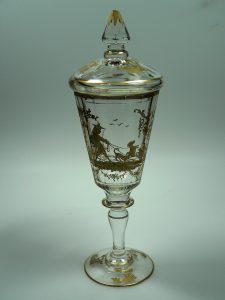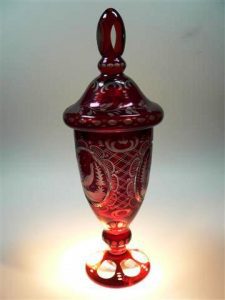Böhmisches Glas: Deckelpokale – Deutsch/German

Die Goldrubingläser kamen Ende des 18. Jahrhunderts als Luxusartikel aus der Mode. An ihre Stelle traten Kristallgläser mit Golddekor – wie der böhmische Deckelpokal vor Ihnen. Um 1840 entwickelte Friedrich Egermann aus Böhmen einen rubinroten Glasfarbstoff, der nicht mehr als Überfang, sondern durch Bemalung auf das farblose Glas aufgetragen werden konnte. Das Glas wurde rot gebeizt beziehungsweise rubiniert. Diese Möglichkeit, jedes Glas rot einzufärben, führte zur Massenproduktion rubinroter Gläser. Besonders beliebt waren Pokale – mit oder ohne Deckel.
Deckelpokale waren in erster Linie Trinkgefäße und der Deckel hatte einen durchaus praktischen Nutzen! Verschmutzung, schnelle Abkühlung oder Erwärmung der Getränke war der eine Grund. Der andere war die panische Angst vor vergifteten Getränken, mit denen unliebsame Herrscher gern aus dem Weg geräumt wurden. Bis ins 18. Jahrhundert reichte deshalb ein Mundschenk die Getränke. Er sorgte dafür, dass der Wein aus den Fässern in gedeckelte Krüge oder Pokale umgefüllt wurde. Diese stellte man dann im Saal auf einer Anrichte, der so genannten Kredenz, zur Schau. Der Name Kredenz, von italienisch „credenza“, bedeutet Vertrauen. Schäumte beim Vorkosten das Getränk oder schwitzte der Mundschenk, wenn er diesem nahe kam, war Gift angezeigt. Erst wenn alle Proben bestanden waren, durfte das Getränk dem Gast gereicht werden.
Bohemian Glass: Goblet with Lid – English

Cranberry, or Gold Ruby glass was a luxury article that fell out of fashion at the end of the 18th century. It was replaced by crystal glasses with gold decor, like the Bohemian goblet with lid before you. In around 1840, Friedrich Egermann from Bohemia developed a ruby-red glass colour that not only overlaid the glass, but could also be painted onto colourless glass. The glass was eiter stained or “ruby-ized,” this of course led to the mass production of ruby-red glass and these goblets, with or without lids, were an especially popular model.
Goblets with lids were used first and foremost for drinking out of and the lid had a practical use: to prevent the contamination, or fast cooling or warming of drinks for one and two, there was also a panic-stricken fear of poisoned drinks at the time, which were used to clear disagreeable rulers out of the way! This is why a cupbearer served the drinks into the 18th century. This person made sure that wine from the barrels was poured into jugs or goblets with lids. These were then put on show in the banqueting hall on a type of sideboard known as a credenza. The name of this piece of furniture is Italian and means trust. If the drink frothed during the cupbearer’s initial tasting, or he began to sweat as he put the goblet to his lips, poison was afoot! So, only when all initial tastings were complete, would the drink be given to a guest.